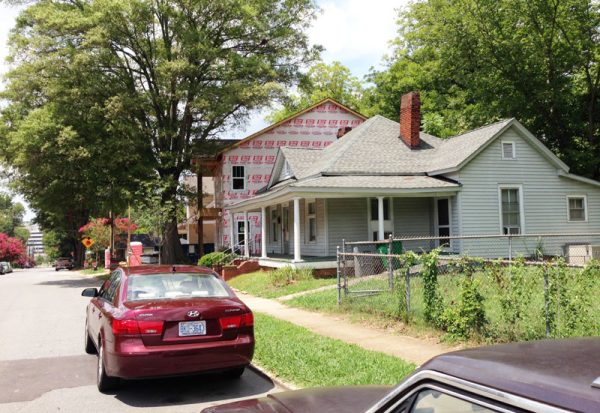Study finds some Charlotte historic districts losing ground

The first comprehensive survey of Charlotte historic resources in 30 years recommends reducing the areas of several of the city’s historic districts, saying development has reduced the historic footprint in those neighborhoods.
Among the findings in the first phase of Charlotte’s Historic Resources Survey:
- In the last 30 years, 37 percent of Charlotte’s potential historic landmarks have been demolished, significantly altered or have deteriorated.
- At least three of Charlotte’s nine historic neighborhoods should reduce their boundaries, most notably Fourth Ward uptown.
- In Dilworth, “if the current pattern and pace of new construction and major additions continue, the status of Dilworth Historic District will be in jeopardy, and the district’s present boundaries will require major modifications.”
- Only four of the 27 blocks in Fourth Ward’s local historic district, the city’s first, still merit historic district designation.
- Several post-World War II subdivisions on Charlotte’s northwest side, such as Double Oaks, Oaklawn and McCrorey Heights, might now be eligible to become historic districts
The Dilworth historic district is mostly intact, the report says, except for several blocks close to the light rail line on South Boulevard, where “the boundaries of the historic district have been compromised … by new construction.” On the other hand, blocks on the southern edges of Dilworth, which were not considered historic in earlier surveys, might now qualify for historic district protection.
More report highlightsRead the full report here. Other highlights include:
|
Neighborhood groups in Dilworth have expressed concern over teardowns and new development projects that they say violate established historic district policy and guidelines.
In the 27-block Fourth Ward historic district, according to the report, “Only a core of four residential blocks appear to have sufficient architectural integrity to warrant local historic district designation.”
In the North Charlotte Historic District, also known as NoDa, “extensive new construction and remodeling” has also occurred.
The survey includes only recommendations, not policy changes, said John Howard, administrator of the Charlotte Historic District Commission. Any changes will have to be approved by the neighborhood associations within each district.
“(The city) is not going to initiate any (historic district) boundary changes,” John Howard said.
The first phase of the survey focused on buildings and neighborhoods inside Charlotte’s “Route 4” ring, which loops clockwise from I-85, around Eastway Drive, Wendover Road, Runnymede Lane, Woodlawn Road and the Billy Graham Parkway. Previous surveys in the 1980s included only properties from the 1930s and earlier. Properties 50 years or older may be included in a historic district, which means several neighborhoods built during Charlotte’s post-World War II boom through 1964 might now be considered historic.
The survey identified several historically black areas on the northwest side of town, such as Double Oaks and Oaklawn Park and the North Graham Street industrial area as potential historic districts.
“In my opinion, all of the northwest side could qualify for the National Register,” said John Howard, Charlotte Historic District Commission administrator. “There’s still the feeling there that, ‘Yeah, it’s a great idea,’ however there’s the second part of it, which is the effect on neighborhood property owners and the socioeconomics of it.”
Charlotte has six local historic districts – Dilworth, Fourth Ward, Hermitage Court, Plaza-Midwood, Wesley Heights and Wilmore. Property owners in these districts are required to comply with architectural design standards and notify the city Historic District Commission when making external changes to their homes.
Four additional neighborhoods – Myers Park, Elizabeth, North Charlotte and Pharrsdale (near Eastover) are on the National Register of historic neighborhoods but aren’t local historic districts. Property owners in National Register historic districts can earn tax credits for maintaining the historic character of their homes, but participation is voluntary.
Neither the local historic district nor National Register status protects any building from demolition, although in local historic districts, the Historic District Commission can choose to delay demolition for up to a year.
Property owners in local historic districts are not eligible for tax breaks unless their neighborhood is also in the National Register. Dilworth and Wesley Heights are both local and National Register Historic Districts.
“What you get from the local historic districts is more qualitative than quantitative,” Howard said. “You get better construction quality. Your house might live longer because it is better maintained; and you would have architectural consistency.”
Rick Mattson of Mattson, Alexander and Associates, said some of the neighborhoods whose historic areas changed the most were not officially designated historic districts. “Of all of those, probably the Cherry neighborhood is the most changed,” Mattson said. “It’s not on the National Register or a Historic District. But if someone had put it on the register, it might have been protected.”
The survey also examined already designated and potential historic landmarks, which are individual properties. Mecklenburg County government administers a local landmarks program, and the National Register also oversees a federal landmark program. Local historic landmarks may still be demolished but the local Historic Landmarks Commission can choose to delay demolition for up to a year.
Of the existing 423 landmarks the consultants surveyed, 101 had been demolished since the 1980s survey and 56 had deteriorated or significantly altered. The remaining 266 remained unchanged or had improved.
“A lot of those demolished buildings were on their way out in previous surveys anyway,” consultant Mattson said. Of the “altered” properties, many were add-ons or modernization of historic structures in highly sought-after, in-town neighborhoods.
The study recommends considering a few post-World War II structures as landmarks, including the St. Peter’s Catholic Church Parsonage and two iconic, 1950s drive-Ins – South 21 on Independence Boulevard and the Bar-B-Que King on Wilkinson Boulevard.
A $20,000 grant from the federal Historic Preservation Fund, plus a $30,000 match from the City of Charlotte helped pay for the first phase of the survey. The second phase, beginning next month, will survey historic resources in the rest of Charlotte.
Click here to download the full Charlotte Comprehensive Architectural Survey, Phase I.